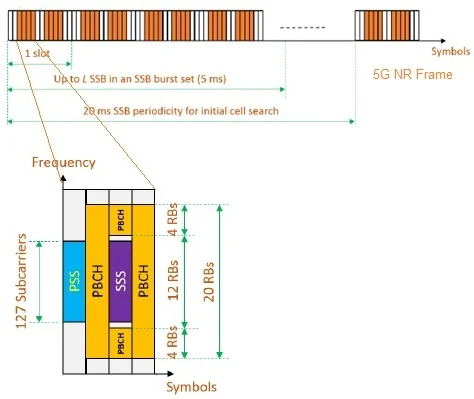Featured post
- Get link
- X
- Other Apps
5G NR SSB-SS, PBCH, Contents, Function, Physical Layer Processing
5G NR SSB-SS, PBCH, Contents, Function, Physical Layer Processing
5G NR SSB function, mapping and 5G NR SSB physical layer processing. The 5G NR SSB consists of SS (i.e. PSS and SSS) and PBCH channels.
In LTE and 5G NR resource grid consists of subcarriers in frequency domain and symbols in time domain. Resource grid is combination of resource blocks (RBs). One RB (resource Block) consists of 12 consecutive subcarriers in frequency domain.
5G NR SSB | PSS, SSS And PBCH

In 5G NR, combination of SS and PBCH (Physical Broadcast Channel) is known as SSB. There two frequency bands supported in 5G NR technology viz. FR1 (Sub-6 GHz) and FR2 (millimeter wave). There are various subcarrier spacing supported in 5G NR viz. 15 KHz, 30 KHz, 60 KHz, 120 KHz and 240 KHz. SSB utilizes subcarrier spacing of 15 or 30 KHz in FR1 and 120 or 240 KHz in FR2.

SS Block : { 1 symbol PSS, 1 symbol SSS, 2 symbols PBCH }
SS Burst : One or multiple SS Block(s)
SS Burst Set : One or multiple SS burst(s), Transmission periodic (default: 20 ms), Confined in 5ms window
As shown, SSB is mapped to 4 OFDM symbols in the time domain versus 20 BRs (i.e. 240 subcarriers) in the frequency domain. Beam sweeping concept is employed in 5G NR for SSB transmission. Multiple SSBs are transmitted periodically at about 20 ms intervals. About 64 SSBs are transmitted in different beams within SS burst set period. SS blocks transmission within single SS burst set is limited to about 5ms window. Frequency location of SSB is condifured by upper layer stack to support sparser search raster in order to detect SSB.
Following are the possible candidate SSB locations (L) within SS Burst Set. Each slot in time domain consists of 2 SS block locations for < 6 GHz for 15 KHz/30 KHz. Each slot consists of 2 SS blocks in 120 KHz for > 6 GHz.
• L = 4 (upto 3 GHz)
• L = 8 (From 3 GHz to 6 GHz)
• L = 64 (From 6 GHz to 52.6 GHz)
• Both SS and PBCH detection helps UE synchronize with the gNB (i.e. 5G base station) during initial network entry phase.
• 5G NR SS consists of PSS (Primary SS) and SSS (Secondary SS). A BPSK modulated m-sequence of length 127 is used for NR PSS where as BPSK modulated Gold sequence of length 127 is used for NR SSS. Both PSS and SSS combination help to identify about 1008 physical cell identities.
• By detecting and decoding SS, UE can obtain physical cell identity, achieve downlink synchronization in time/frequency domain and acquire time instants of PBCH channel. Center frequency of PSS/SSS is aligned with center frequency of PBCH.
• PBCH carries very basic 5G NR system informations for UEs. Any 5G NR compatible UE must have to decode information on PBCH in order to access the 5G cell.
• Information carried by PBCH include following.
-Downlink System BW
-Timing information in radio frame
-SS burst set periodicity
-System frame number
-Other upper layer informations

5G NR PBCH
• PBCH TTI : 80 ms
• PBCH payload : 56 bits including CRC
• PBCH channel coding scheme: Polar code
• The figure depicts physical layer processing for PBCH information. The coded bits of PBCH code blocks are mapped across REs in PBCH. Two scrambling operations are performed as shown.
Refer complete article on 5G NR Physical Layer >>
- Get link
- X
- Other Apps
Popular Posts
5G NR MAC Layer-Architecture, Channel Mapping, Procedures
- Get link
- X
- Other Apps
5G NR TBS Calculation | 5G NR Transport Block Size Calculation
- Get link
- X
- Other Apps

Comments
Post a Comment